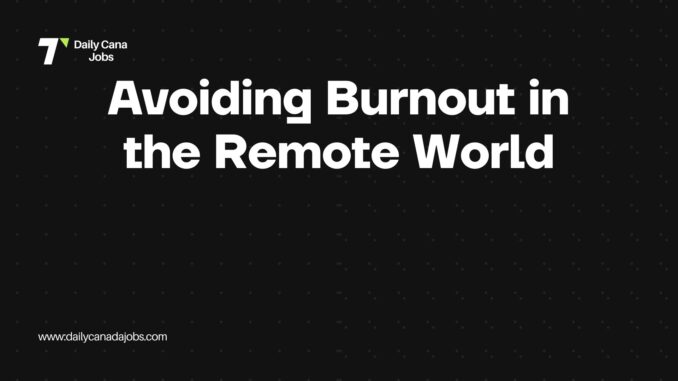
Remote work offers incredible flexibility and freedom, but it also comes with unique challenges that can lead to burnout. Without the clear boundaries between work and home, many remote workers find themselves working longer hours and struggling to disconnect. In this guide, we’ll explore effective strategies to prevent burnout, maintain your energy, and stay engaged while working remotely.
Understanding Remote Work Burnout
Remote work burnout differs from traditional workplace burnout in several key ways. When your home becomes your office, the lines between professional and personal life can blur, making it difficult to truly “leave work” at the end of the day.
Common signs of remote work burnout include:
- Feeling exhausted despite getting enough sleep
- Decreased productivity and motivation
- Increased cynicism about your work
- Difficulty concentrating
- Physical symptoms like headaches or insomnia
- Feeling isolated or disconnected from colleagues
Recognizing these warning signs early is crucial for preventing full-blown burnout.
Creating Physical Boundaries
One of the most effective ways to prevent burnout is to create clear physical boundaries between your work and personal life.
Strategies for establishing physical boundaries:
- Set up a dedicated workspace that you can leave at the end of the day
- Avoid working from your bedroom or relaxation areas
- Use physical cues to signal the beginning and end of work (like changing clothes)
- Put away your work equipment when you’re done for the day
- Consider using a separate computer or phone for work
These physical boundaries help your brain distinguish between “work mode” and “home mode,” making it easier to disconnect.
Establishing Time Boundaries
Without the structure of a traditional office, it’s easy to let work expand to fill all available time. Setting clear time boundaries is essential for preventing burnout.
Effective time management strategies:
- Set consistent working hours and stick to them
- Use calendar blocking to schedule focused work time and breaks
- Create morning and evening routines to transition in and out of work
- Use time-tracking tools to ensure you’re not overworking
- Communicate your working hours to colleagues and clients
Remember that productivity isn’t about working more hours—it’s about making the most of the hours you work.
Taking Meaningful Breaks
Regular breaks are essential for maintaining energy and focus throughout the day. Remote workers often forget to take breaks, leading to decreased productivity and increased stress.
Ideas for effective breaks:
- Follow the Pomodoro Technique (25 minutes of work followed by a 5-minute break)
- Take a proper lunch break away from your desk
- Go for a short walk outside to get fresh air and natural light
- Do quick stretching or exercise sessions between meetings
- Practice brief meditation or deep breathing exercises
These breaks aren’t wasted time—they’re investments in your productivity and well-being.
Combating Isolation and Loneliness
Social isolation is one of the biggest contributors to remote work burnout. Without the casual interactions of an office environment, remote workers can feel disconnected and lonely.
Ways to stay socially connected:
- Schedule virtual coffee breaks with colleagues
- Join online communities or forums related to your industry
- Attend virtual networking events or webinars
- Work occasionally from coffee shops or co-working spaces
- Maintain regular social activities outside of work
Human connection is vital for our mental health and can significantly reduce the risk of burnout.
Prioritizing Physical Health
Physical health directly impacts your energy levels and resilience to stress. Remote workers often neglect physical health due to convenience and lack of structure.
Strategies for maintaining physical health:
- Create a consistent sleep schedule
- Prepare healthy meals and snacks instead of constant grazing
- Set up an ergonomic workspace to prevent physical strain
- Schedule regular exercise into your day
- Stay hydrated throughout your workday
Taking care of your body gives you the energy and stamina needed to perform at your best.
Practicing Digital Wellness
Constant connectivity can contribute significantly to burnout. Setting healthy boundaries with technology is essential for remote workers.
Digital wellness practices:
- Turn off notifications during focused work periods
- Use apps that limit screen time or block distracting websites
- Implement a digital sunset by avoiding screens before bedtime
- Take regular screen breaks to rest your eyes
- Completely disconnect during vacations and weekends
Remember that being always available doesn’t make you more productive—it makes you more likely to burn out.
Communicating Your Needs
Many remote workers hesitate to communicate their needs and boundaries, fearing they’ll be seen as less committed. However, clear communication is essential for preventing burnout.
Tips for effective communication:
- Be transparent with your manager about your workload
- Discuss expectations around response times and availability
- Ask for help when you need it
- Negotiate for flexible hours if it would benefit your well-being
- Provide regular updates to reduce anxiety about your productivity
Most employers would rather adjust expectations than lose a valuable employee to burnout.
Finding Meaning and Purpose
Feeling disconnected from the purpose of your work can accelerate burnout. Remote workers need to actively cultivate a sense of meaning and accomplishment.
Ways to maintain purpose and motivation:
- Regularly reflect on how your work contributes to larger goals
- Celebrate small wins and milestones
- Keep a “success journal” to document your achievements
- Connect with the people who benefit from your work
- Pursue projects that align with your values and interests
When you find meaning in your work, you’re more resilient to the challenges of remote work.
Leave a Reply